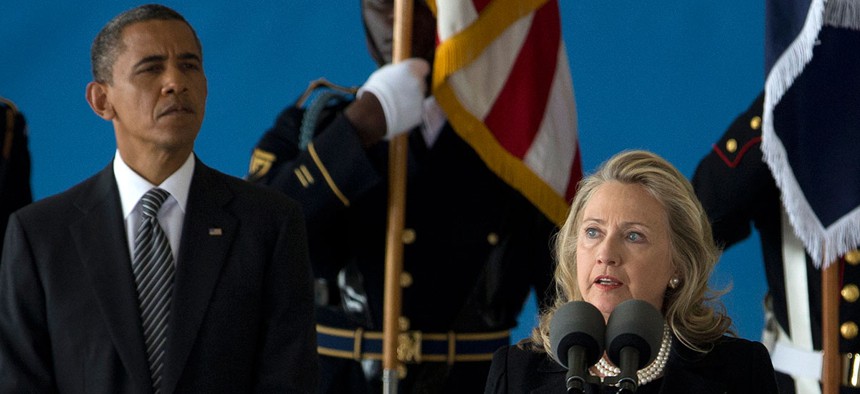
Clinton and Obama appear together at Andrews Air Force Base in 2012. Carolyn Kaster/AP file photo
Why the Clinton-Obama Road Show Is Launching in a Different State
The switch in their first joint campaign appearance is a reflection of the Democrats' confidence—and her lead in the polls.
There are two simple ways to cut through the bluster and the spin to see how a presidential campaign is really feeling about its prospects at any given moment: You can follow the money, and you can follow the plane.
Is a candidate retrenching by spending more time and ad dollars in states their party has won in the past and must hold onto in November? Or is he or she being more aggressive—and aspirational—by trying to expand the map and add states that are more difficult, and potentially less crucial, to capture the White House?
On Wednesday, the Hillary Clinton campaign offered up a clue to its level of confidence when it announced that it had rescheduled a joint event with President Obama—the first since he endorsed his former secretary of state—for July 5. The rally was originally scheduled for mid-June, but was canceled following the Orlando shooting. What was notable about the announcement, however, is that the Clinton-Obama road show is launching in a different state than the campaign first planned. The postponed rally was to occur in Wisconsin, a state that Democrats haven’t lost in a presidential year since 1984 but which had been seen as a potential pickup for Donald Trump. Clinton and Obama will instead appear in North Carolina, which the president won narrowly in 2008 but lost four years ago.
Few election prognosticators believe the Tar Heel State will be a big difference-maker to Clinton’s hopes in November; if she wins there, Clinton likely will have won the presidency comfortably. Taking North Carolina, in other words, is more about running up the score.
Why the switch? Just look at the polls. The Clinton campaign announced the original Obama rally on June 9, but it was probably agreed upon a few days earlier when the president decided to endorse her. In early June, her lead over Trump in the Real Clear Politics average was about two points. Three weeks later, after a damaging month for the presumptive Republican nominee, Clinton’s advantage is more than six points. Clinton’s lead in Wisconsin is more than seven points in the RCP average, while in North Carolina, Trump has a slight advantage.
The campaign still wants to use Obama chiefly as a validator for Clinton who can reach out to Bernie Sanders’s supporters by citing his own past suspicions of her. As White House communications director Jen Psaki told Politico, the president is “the highest-profile convert” in Clinton’s corner. That seemed to be the idea behind sending Obama and Clinton to Wisconsin, a state that Sanders won in the primaries. But she needs the suddenly popular president to excite the Democratic base, whether it is by persuading white liberals in Green Bay or making sure African Americans in Charlotte turn out for her in the same numbers they did twice for him.
Swapping out Wisconsin for North Carolina now doesn’t mean Clinton and Obama won’t return to the Badger State later (together or separately), either because the race tightens again or perhaps to help Democrat Russ Feingold in his bid to win back the Senate seat he lost in 2010. Obama is expected to campaign frequently on Clinton’s behalf later this summer and fall. Yet in contrast to Trump, who has campaigned already in several states that don’t figure to be competitive in November, Clinton has been exceedingly deliberate in her schedule so far. Choosing one state for another to campaign with her most powerful new surrogate for the first time isn’t just about logistics. It reflects a campaign that has swung solidly toward her in the last few weeks.






